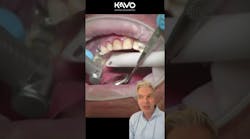Venus Diamond earns high marks in studies
Two in vivo studies at Italy’s University of Brescia have confirmed the long-term clinical and esthetic performance of Venus Diamond by Heraeus Kulzer, LLC. After three years of rigorous testing, the universal composite achieved consistently high marks in both studies with regard to marginal adaptation, marginal discoloration, anatomical form, color matching ability, surface texture and retention for class III, IV, and V restorations.
“Dentists need and deserve to have confidence that their restorative materials will consistently deliver exceptional long-term outcomes,” said Christopher Holden, Heraeus president. “The impressive results of these two studies confirm what our own studies and customer feedback have shown: that Venus Diamond enables dentists to produce extremely natural and durable restorations with little effort.” Combining an innovative and patented monomer matrix with a balanced nanohybrid filler system, the Venus Diamond universal composite produces an unprecedented blend of low shrinkage stress and high strength, long-lasting natural esthetics.
The first study focused on class V restorations, while the second focused on class III and class IV restorations.
Split-mouth study on class V restorations
In a controlled randomized split-mouth study, the Department of Restorative Dentistry at the University of Brescia assessed the clinical and esthetic performance of Venus Diamond combined with Heraeus’ Gluma Comfort Bond in class V restorations. The results were compared to a control group treated with another leading composite and adhesive material. In the study, 60 class V restorations were placed, using Venus Diamond and Gluma Comfort Bond for the test group and another competitive composite and adhesive material for the control group. The fillings were evaluated according to USPHS (United States Public Health Service) standards.
At the final re-evaluation after three years, the recall rate was 100 percent. While 27 percent (n=8) of the restorations were lost in the control group, only 13 percent (n=4) of the Venus Diamond restorations were lost. All evaluated teeth remained free of secondary caries, all fillings were intact, and all study teeth were vital and sound. In both groups, there was a total absence of postoperative discomfort to temperature or occlusion, and every restoration kept its anatomical form.
In all categories evaluated, after 36 months the combination of Venus Diamond and Gluma Comfort Bond demonstrated strong class V clinical behavior and performed as well as or better than the control group. For example, Venus Diamond and Gluma Comfort Bond received alpha (optimal) evaluated fillings ratings of 69 percent for marginal adaptation versus 64% for the control group.
Clinical evaluation of class III and IV restorations
A second in vivo study at the University of Brescia evaluated the clinical and esthetical performance of Venus Diamond in class III and IV anterior cavities. In the study, 24 class III and IV restorations were placed with Venus Diamond using a micro-layering technique, with Gluma Comfort Bond being used as adhesive. As with the class V study, the USPHS evaluating system was utilized. The recall rate was 83%, as four patients fell short of the three-year control. All reviewable placed restorations were present.
In the evaluation, alpha (optimal) marks were an impressive 100 percent for marginal discoloration and 83 percent for marginal adaptation, testifying to the outstanding marginal properties of Venus Diamond. All restorations kept their anatomical form, and no filling showed fracture or loss of either retention of interproximal contacts. All teeth were caries-free, vital and sound, and all patients reported being satisfied. The fillings received alpha (optimal) ratings of 61 percent for color match, and 100 percent of the restoration surfaces were rated as smooth or slightly smooth. None of the tested parameters recorded lower than a bravo (clinically acceptable) rating.
Conclusion: excellent long-term performance and ease-of-use
Principal investigator Professor Antonio Cerutti, Head of the Department of Restorative Dentistry at the University of Brescia, not only testified to the excellent esthetic and clinical behavior of Venus Diamond in the two studies, he also commended the universal nanohybrid composite for its outstanding handling and polishing abilities.
Both studies are continuing in order to corroborate the exceptional clinical results beyond the 36-month timeframe.
For more information on Venus Diamond or Gluma Comfort Bond, visit www.heraeusdentalusa.com or call (877) 431-1785.

